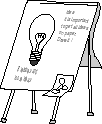IT, Høgskolen i Østfold
IT, Høgskolen i Østfold
Program design, as I understand it, is a more or less systematic moulding of an idea to a running program. We must put some demands on an idea that may serve as foundation for this process. Designation of a topic is not sufficient. Formulations like "I want to make a program for learning languages" or "We need a program to teach coordinate systems in mathematics" is not ideas. At best it may be characterised as an expression of want or a good intention.
An idea must of course clarify the topic that will be treated, but it must incorporate something more. We must have some thoughts about how the topic should be treated, and we must have a feel for the dynamics and the perspective.
Often a good program idea is characterised by a new and original perspective. We want to experience an intuitive feeling that the idea is different, in some respect, from known programs and earlier solutions.
It should be useful an engaging. We will of course have to test the usefulness against the objective. We should also incorporate in the idea a very coarse understanding of how the technology can contribute to a better way to work or learn.
It seems to be a general comprehension that the good ideas almost by chance drop into the heads of a few talented and creative individuals, and the only way one can hope to "get an idea" is to wait patiently. Often ideas has roots in the experience of a teacher, but good ideas may have unexpected sources. Even if the project is initiated as a result of a requirement analysis, the idea should be sought and worked on.
It no doubt happens that ideas appear apparently out of the blue and occupies your mind without forewarning and mercy. But usually generating ideas is hard work which involves both mental preparation and a methodical approach.
If there is anything like a talent for program design, this talent is a balanced combination of madness and discipline. The madness should open up for chains of thought that is not necessarily feasible or apparently fruitful. Discipline means that the designer can take two steps back and evaluate and modify the thoughts in a systematic manner. In a design team it is crucial to allow and nourish both these approaches.
The work with an idea will give birth to a lot of sketches that will not be used. Don't throw them away, they may be useful in later projects and the subconsciousness will continue to work with them as sources for inspiration.
A characteristic of professional design is that the ability to be creative can be maintained even when that first elation has passed and things get difficult and boring. This always happens, and it is important to be ready for it.
We must analyse different aspects of the idea. One important issues is that of technological limitations. It is a clear experience that most people tends to underestimate the technological possibilities when it comes to concrete program design. This goes for computer experts as well as other members of a design team. We should try to avoid this kind of technologically based self censorship in the start of a design process.
The main thing to look for is the simple aesthetics and consistency. This is to a great amount a question of intuition.

To pursue an idea means two things. First you must make it clear to yourself. Secondly you must make it clear to others. For both purposes the idea should be materialised in one form or another.
The description should be short and to the point. It is very easy to get into discussions with yourself or others about details that is better resolved in a later stage in the work. As a rule it should be possible to communicate the idea on one blackboard or one big sheet of paper. The description should consist of little text and many sketches. If the idea is hard to draw, it should be considered a warning signal. Diffuse ideas are hard to draw. Avoid square drawings with window frames. This will lock up your design at a too early stage.
Baptise your idea. It is much easier to work with an idea with a catchy name. Tell it to others. This will most certainly make it easier to communicate about the idea, and you will get questions and suggestions from your colleagues.